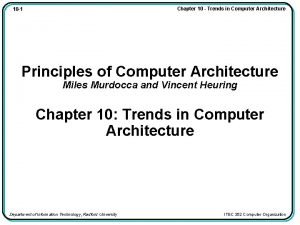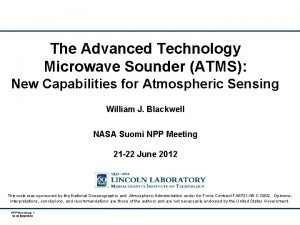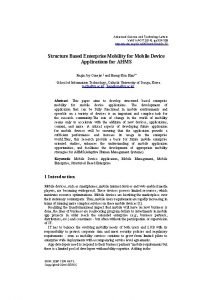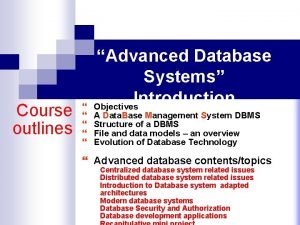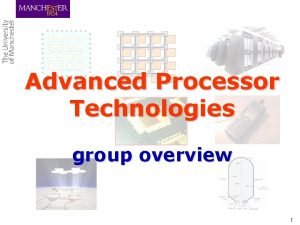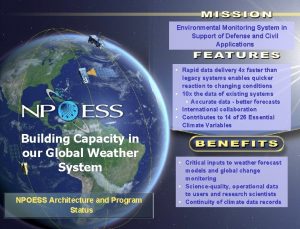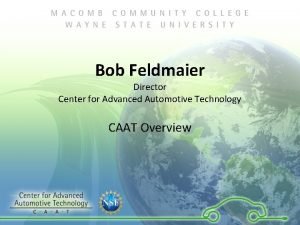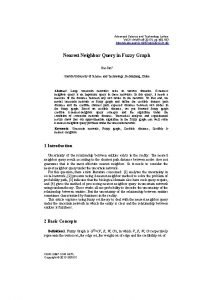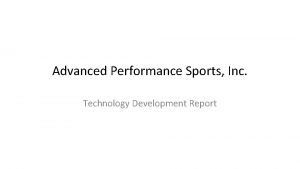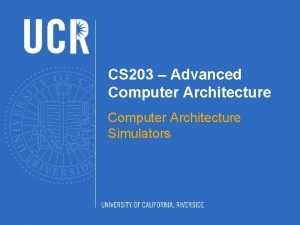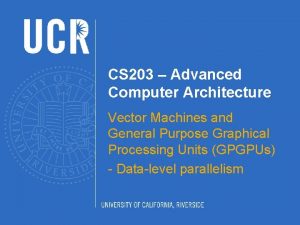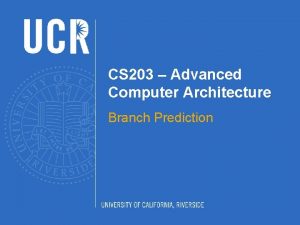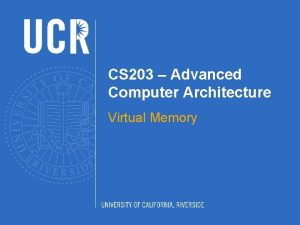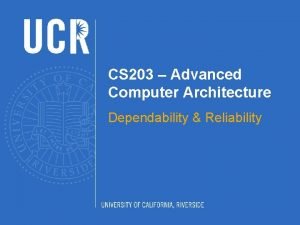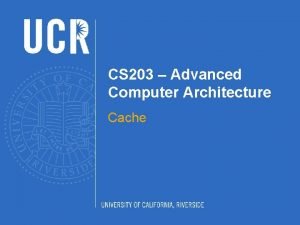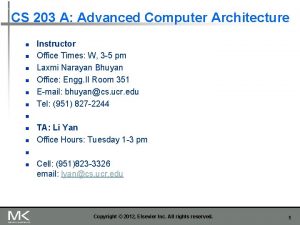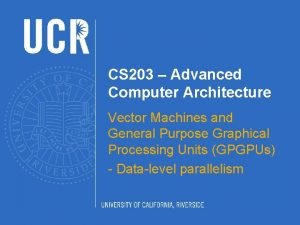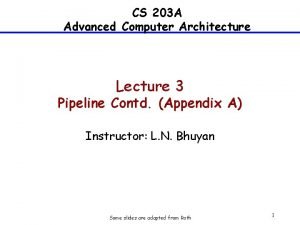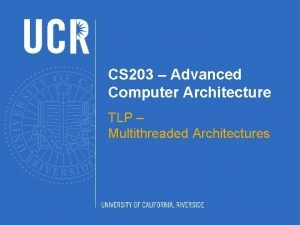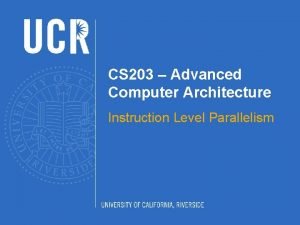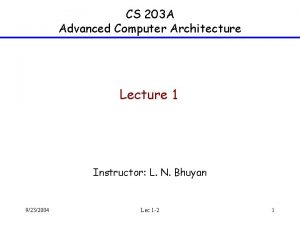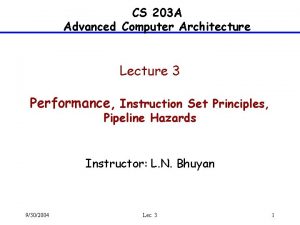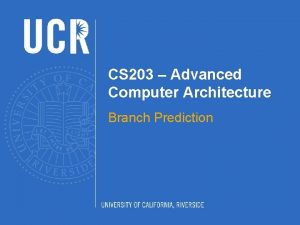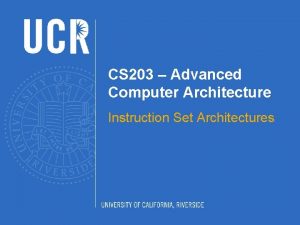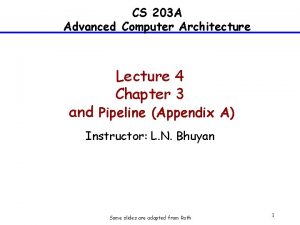CS 203 Advanced Computer Architecture Technology Trends Trends






















- Slides: 22

CS 203 – Advanced Computer Architecture Technology Trends

Trends in Technology - Density Integrated circuit technology Transistor density: 35%/year Die size: 10 -20%/year Integration overall: 40 -55%/year DRAM capacity: 25 -40%/year (slowing) Flash capacity: 50 -60%/year 15 -20 X cheaper/bit than DRAM Magnetic disk technology: 40%/year 15 -25 X cheaper/bit then Flash 300 -500 X cheaper/bit than DRAM 2

Bandwidth and Latency Trends Bandwidth or throughput Total work done in a given time 10, 000 -25, 000 X improvement for processors 300 -1200 X improvement for memory and disks Latency or response time Time between start and completion of an event 30 -80 X improvement for processors 6 -8 X improvement for memory and disks 3

Bandwidth and Latency Log-log plot of bandwidth and latency milestones

TRANSISTORS 5

Transistors and Wires Feature size Minimum size of transistor or wire in x or y dimension 10 microns in 1971 to. 032 microns in 2011 32 nm 22 nm (‘ 12) 14 nm (‘ 14) 10 nm (? ) Transistor performance scales linearly Wire delay does not improve with feature size! Integration density scales quadratically 6

Technology Scaling Moore’s Law: All these features scale by 1/S, S=SQRT(2) every 2 years 7

Moore’s Law 8

Impact of Scaling on Characteristics Device Characteristics Feature Dependence Scaling Transistor Gain (β) W/(L. tox) S Current (Ids) β(Vdd-Vth)2 S Resistance Vdd/Ids 1 Gate Capacitance (W. L)/tox 1/S Gate delay R. C 1/S Clock Frequency 1/(R. C) S Circuit Area W. L 1/S 2 Wire Resistance 1/(w. h) S 2 Wire Capacitance h/s 1 9

Effects of Technology Scaling dimensions doubles device density Frequency increases by 41% Scaling voltage simultaneously keep the power constant If voltage is not scaled then clock frequency can scale even faster but dynamic power grows! Threshold voltage scaling causes gate leakage power growth! 10

Technology Trends Wire delays don’t scale like logic delays Processor structures must expand to support more instructions Thus wire delays dominate the cycle time; slow wires must be local Design complexity Processors are becoming so complex that a large fraction of the development of a processor or system is dedicated to verification Chip density is increasing much faster than the productivity of verification engineers (new tools, speed of systems) CMOS endpoint CMOS is rapidly reaching the limits of miniaturization Feature sizes will reach atomic dimensions in less than 15 years Options? ? Quantum computing Nanotechnology Analog computing Performance remains a critical design factor 11

POWER AND ENERGY 12

Power Total power: dynamic + static (leakage) Pdynamic = αCV 2 f Pstatic = VIsub ≈ Ve-KVt/T Power/energy are critical problems Power (immediate energy dissipation) must be dissipated Otherwise temperature goes up (affects performance, correctness and may possibly destroy the circuit, short term or long term) Effect on the supply of power to the chip Energy (depends on power and speed) Costly; global problem Battery operated devices 13

Dynamic Energy and Power Dynamic power Pdynamic = αCV 2 f α = fraction of clock period where output 0 1 (at most ½) Dynamic energy Transistor switch from 0 1 or 1 0 Edynamic = αCV 2 Reducing clock rate reduces power, not energy 15

Power Trends Intel 80386 consumed ~ 2 W 3. 3 GHz Intel Core i 7 consumes 130 W Heat must be dissipated from 1. 5 x 1. 5 cm chip This is the limit of what can be cooled by air 16

Why multi-core? Pdynamic = αCV 2 f Dynamic power favors parallel processing over higher clock rate Dynamic power roughly proportional to f 3 Take a proc. and replicate it 4 times: 4 x speedup & 4 x power Take a proc and clock it 4 times faster: 4 x speedup but 64 x dynamic power! 17

Example of quantifying power Suppose 15% reduction in voltage results in a 15% reduction in frequency. What is impact on dynamic power? 18

Static Power Because leakage current flows even when a transistor is off, now static power important too Leakage current increases in processors with smaller transistor sizes Increasing the number of transistors increases power even if they are turned off Very low power systems gate voltage to inactive modules to control loss due to leakage 19

Reducing Power Techniques for reducing power: Do nothing well (Idle low power modes) Dynamic Voltage-Frequency Scaling Low power state for DRAM, disks Overclocking, turning off cores 20

COST 21

Trends in Cost driven down by learning curve Yield DRAM: price closely tracks cost Microprocessors: price depends on volume 10% less for each doubling of volume 22

Integrated Circuit Cost Integrated circuit Defects per unit area = 0. 016 -0. 057 defects per square cm (2010) N = process-complexity factor = 11. 5 -15. 5 (40 nm, 2010) 23
 Computer architecture
Computer architecture Trends in computer architecture
Trends in computer architecture Memory technology in computer architecture
Memory technology in computer architecture 3 bus architecture
3 bus architecture Computer architecture and computer organization difference
Computer architecture and computer organization difference Interrupt cycle flow chart
Interrupt cycle flow chart Ah geography understanding standards
Ah geography understanding standards Aesthetic advanced technology
Aesthetic advanced technology Advanced technology microwave sounder
Advanced technology microwave sounder Advanced science and technology letters
Advanced science and technology letters Technology operating modelsê
Technology operating modelsê Advanced refrigeration technology
Advanced refrigeration technology Advanced processor technology
Advanced processor technology Advanced technology microwave sounder
Advanced technology microwave sounder Advanced technology microwave sounder
Advanced technology microwave sounder Bob caat
Bob caat Apex advanced technology
Apex advanced technology Advanced science and technology letters
Advanced science and technology letters Advanced processor technology
Advanced processor technology Performance sports inc
Performance sports inc Hardware technology trends
Hardware technology trends Social and ethical issues in information systems
Social and ethical issues in information systems Rad 203
Rad 203

